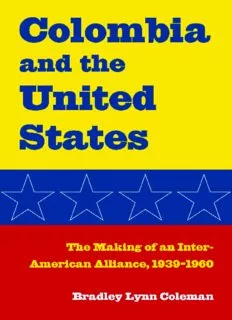
Colombia and the United States: The Making of an Inter-American Alliance, 1939-1960 PDF
Preview Colombia and the United States: The Making of an Inter-American Alliance, 1939-1960
Colombia and the United States NEW STUDIES IN U.S. FOREIGN RELATIONS Mary Ann Heiss, editor The Birth of Development: How the World Bank, Food and Agriculture Organization, and World Health Organization Changed the World, 1945–1965 amy l. s. staples Colombia and the United States: The Making of an Inter-American Alliance, 1939–1960 bradley lynn coleman Colombia and the United States The Making of an Inter-American Alliance, 1939–1960 } Bradley Lynn Coleman The Kent State University Press Kent, Ohio © 2008 by The Kent State University Press, Kent, Ohio 44242 all rights reserved Library of Congress Catalog Card Number 2007044972 isbn 978-0-87338-926-6 Manufactured in the United States of America library of congress cataloging-in-publication data Coleman, Bradley Lynn, 1973– Colombia and the United States : the making of an inter-American alliance, 1939–1960 / Bradley Lynn Coleman. p. cm. — (New studies in U.S. foreign relations) Includes bibliographical references and index. isbn 978-0-87338-926-6 (hardcover : alk. paper) ∞ 1. United States—Foreign relations—Colombia. 2. Colombia—Foreign relations—United States. 3. United States—Military relations—Colombia. 4. Colombia—Military rela- tions—United States. I. Title. e183.8.c7c65 2008 327.730861—dc22 2007044972 British Library Cataloging-in-Publication data are available. 12 11 10 09 08 5 4 3 2 1 a mi esposa Contents Preface ix Introduction: A Global History xiii Maps and Illustrations xix 1 Solidarity and Cooperation, 1939–1945 1 2 Old Problems, New Possibilities, 1945–1950 43 3 The Korean War and the Americas, 1950–1951 71 4 The Fighting Alliance, 1951–1953 97 5 Continuity and Change, 1953–1957 138 6 The Partnership Transformed, 1958–1960 171 Epilogue 199 Essay on Archival Research 205 List of Abbreviations 211 Notes 213 Bibliography 272 Index 294 Preface In 1997 I decided to write a book about the Korean War, a comparative history of small-country United Nations (UN) military forces. At the University of Georgia, I planned a series of seminar papers, each covering a different UN member state. The sum of those essays, I thought, would form my doctoral dissertation, the first draft of my intended book. After some preliminary research, I started with the Colombian Army in Korea. I discovered, in the process, the fascinating and large- ly untold story of Colombia, Colombian-American cooperation, and U.S.–Latin American relations during the Korean War. Over the years that followed, my in- ternational history of the UN army drifted away from its concentration on Korea. A 2001 trip to Bogotá, in particular, altered the direction of the work. This book, therefore, is the unintended product of an unexpected journey. Its publication stirs contradictory feelings within me, the author: pride, humility, and gratitude. It is the most comprehensive account of U.S.-Colombian security relations published to date. It contains useful information and analyses. Still, my ability to reconstruct that past is necessarily limited. I am responsible for any errors in fact, interpreta- tion, or presentation. Yet above all, I know that the entire undertaking would have been impossible without the assistance of many individuals and institutions. Larry Bland, Thomas Davis, and D. Clayton James devoted special attention to my historical education at the Virginia Military Institute. At Temple University, Richard Immerman and Russell Weigley nurtured my interest in military and diplomatic history. William Stueck supervised my doctoral studies at the Univer- sity of Georgia. Among his many generous acts, Professor Stueck diverted money from his personal research fund to support my work in Colombia. Lester Lang- ley taught me about the inter-American neighborhood. William Leary, Reinaldo Román, and Thomas Whigham also made lasting intellectual impressions. Julie Dyles cheerfully attended to all my interlibrary loan requests. David Bushnell, James Henderson, Stephen Randall, Russell Ramsey, Dennis Rempe, César Torres Del Río, and Álvaro Valencia Tovar helped me learn more about Colombia, its armed forces, and its relationship with the United States. The staffs of the Archivo General de la Nación (Bogotá), Archivo de la Presi- dencia de la República (Bogotá), Biblioteca Nacional (Bogotá), U.S. National Ar- chives (College Park, Maryland), Library of Congress (Washington, D.C.), George ix
Description: